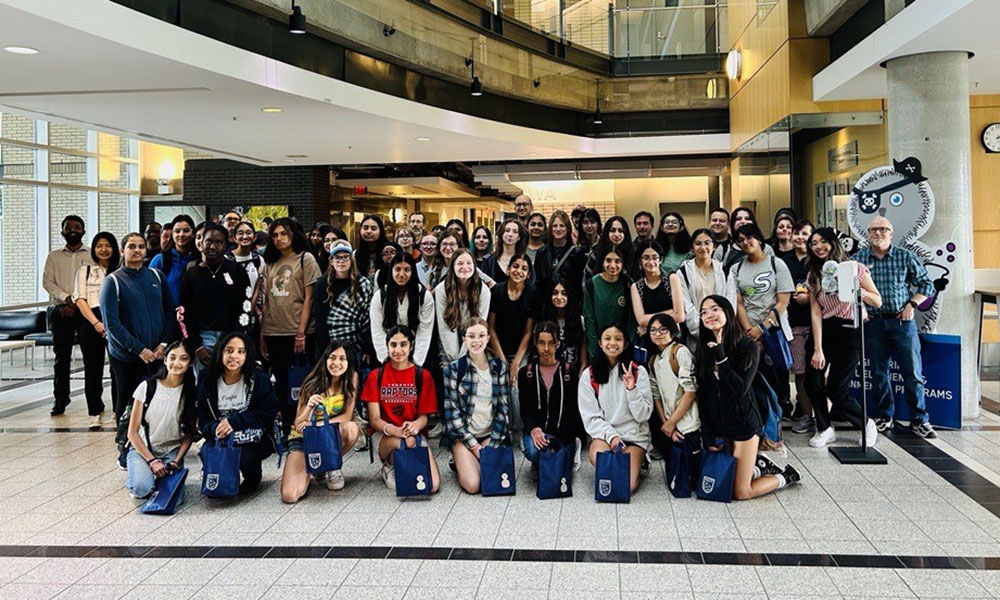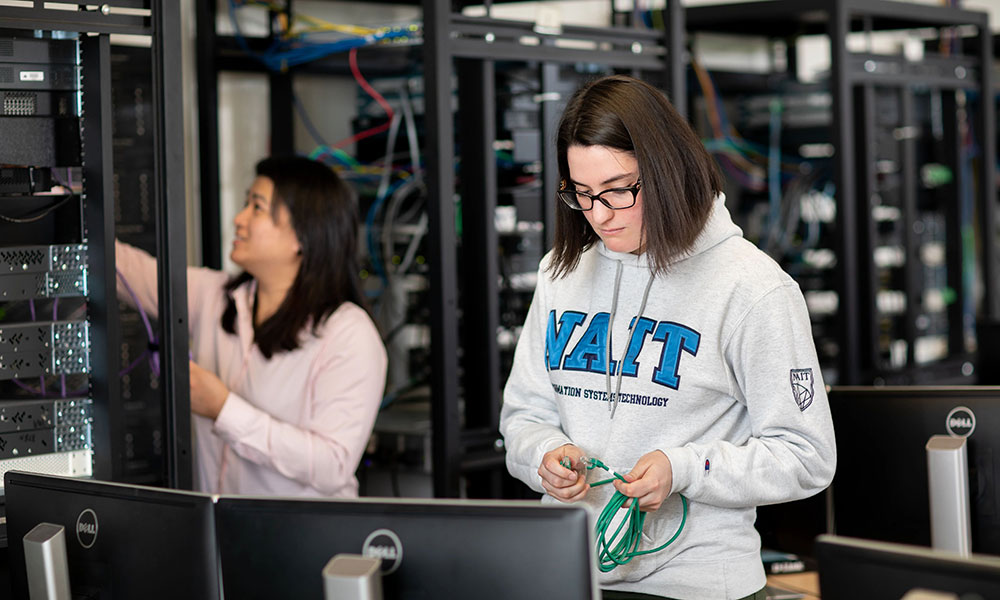Greater awareness of opportunities could help address disparity
Growing up in a small town, Stephanie Remniak (Bachelor of Applied Information Systems Technology ’17) wasn't very familiar with computer science and IT. In Grade 12, a couple of courses showed her the basics.
“A little bit of coding,” recalls the Computer Network Administrator chair, “and a little bit of spreadsheets.” That is, almost nothing. But it was enough to spark a passion she’d need to investigate more deeply on her own.
“I didn't have that exposure until college,” she says.
Kids’ exposure to the world of computing has improved since Remniak got her first glimpse of a possible career. Even so, that difference isn’t exactly showing in post-secondary or industry.
Statistics Canada puts the first-year post-secondary participation rate of women in computer and information sciences at just under 16%. It also notes that, for science and tech in general, only half of women with credentials actually put them to work in industry, whereas 75% of male grads enter the field.
Remniak sees similar enrolment numbers in her program. (More broadly at NAIT, female enrolment in programs within the School of Applied Sciences and Technology are marginally better, at 28.4%.)
Last May, she and her team took a new approach to boosting representation by inviting a group of students from Edmonton Public Schools, grades 9 to 12, to visit NAIT and learn about IT. They did a scavenger hunt that required building networks and computers to access clues, learned about programming to control robots, and more.
Remniak and her colleagues wanted to build a sense of understanding and excitement about the field – and dispel myths.
“We showed them a wide variety of different IT aspects,” she says, and that the field involves more than just sitting at a computer. “I think it was a bit of an eye-opener.”

While her focus is on ensuring that female students are aware of opportunities, Remniak knows that she’s also working to meet a need in industry – with which she meets regularly through a program advisory committee.
“They’re crying to have females,” says Remniak. Employers tend to see women as being better at multitasking (which has been shown to be true) and to be strong managers that encourage greater staff engagement (also true). What’s more, they recognize that we’re now a quarter of the way through the 21st century – a time in which true inclusion should be the norm.
From a business standpoint, says Remniak, companies want to be seen as meaningfully and genuinely modern.
“Their clients could say, ‘Hey, how come you don't have more diversity in your organization?’”
Remniak knows there’s still much progress to be made – and that, sadly, it's probably going to come slowly. “Could I say in 10 years that things are going to change?” she says. “We thought [that] 10 years ago.”
But she’s not giving up. To keep raising awareness of that need for change – and entice more female students into considering the profession – Remniak and her group will push for more events for junior and high school students this year. She wants them to see a place for themselves at NAIT.
“We strongly encourage getting girls in at a young age to learn about this,” Remniak adds.
Until then, here are four recommendations she and her colleagues shared for International Women’s Day for improving female representation in computer sciences and IT.
4 ways to improve female representation in IT

“Honestly, I did not know ‘IT’ was an option when I was in high school. I’m sure it has changed since then but [let’s get] STEM [science, technology, engineering and math] reps out to elementary, junior high, or high school early on.”
– Nichol Campbell (Bachelor of Applied Information Systems Technology ’19, Network Engineering Technology ’17), Instructor, BAIST – Network Management Major
“Get more men involved in promoting women in STEM. You do not need to be a woman to promote and encourage women.”
– Monica Ciobanu (BAIST ’11, Computer Network Administrator ’09), Instructor, Network Engineering Technology
“Women in STEM flourish and thrive when we have a team that is inclusive and respectful regardless of the gender of the team.”
– Aina Del Pilar (BAIST ’19, Network Engineering Technology ’17), Education Lab Technologist, Computer Network Administrator and Network Engineering Technology
“I would like to see organizations have more support and mentorship groups for women – women supporting and mentoring women.”
– Stephanie Remniak, Chair, Computer Network Administrator
Inclusion at NAIT

There are plenty of examples of female student success at NAIT, says president and CEO Laura Jo Gunter, such as a recent win by the polytechnic’s first all-female team at the IKA Culinary Olympics, or the records set by Ooks hockey goal Kaitlyn Slator. But there is also much work to be done to foster inclusion, diversity and equity on campus.
“International Women’s Day compels us to reflect on the broader challenges that remain,” says Gunter. “Achieving gender equality requires ongoing effort, advocacy and commitment to supporting all women's safety, respect and opportunities.”
“International Women’s Day compels us to reflect on the broader challenges that remain.”
Part of this commitment is embodied by NAIT’s first Equity, Diversity and Inclusion Strategy. Released in 2021, the document shows a way forward to creating a more welcoming campus.
“NAIT’s dedication to equity, diversity and inclusion is a continuous journey that requires our collective action,” Gunter adds. “By learning about all women’s experiences in our vibrant community and beyond, we can continue to make sure that every individual feels empowered to achieve their full potential.”
Download a copy of NAIT’s Equity, Diversity and Inclusion Strategy